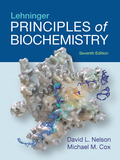
Concept explainers
(a)
To determine: The general type of enzyme and cofactor(s) or reactants required during dehydrogenation reactions that would result in the formation of the product.
Introduction:
The fats disintegrate into fatty acids and glycerol. The fatty acids enter Krebs’s cycle and get involved in beta-oxidation where its carbons are removed and acetyl CoA (acetyl coenzyme A) are formed. The cholesterol molecules are formed by the utilization of acetyl CoA molecules.
(b)
To determine: The general type of enzyme and cofactor(s) or reactants required in isomerization of L- and D- leucine..
Introduction:
The amino acids are the building blocks of the macromolecules proteins. There are twenty amino acids required to make proteins in all organisms. These proteins participate in the
(c)
To determine: The general type of enzyme and cofactor(s) or reactants required in interconversion of glucose and fructose.
Introduction:
The sugars are carbohydrates that include monosaccharides and disaccharides. The sugars include glucose, sucrose, fructose, maltose, and many more sugars. The sugars are interconvertible and get converted into glucose. The glucose enters glycolysis and generates cellular energy in terms of ATP (Adenosine triphosphate).
(d)
To determine: The general type of enzyme and cofactor(s) or reactants required in the phosphorylation of glycerol to glycerol-3-phosphate.
Introduction:
The digestive products of the fats are “glycerol” and “fatty acids”. The lipase acts on the fat molecules and, the fatty acid and glycerol molecules are formed. The fats are digested in the small intestine.
(e)
To determine: The general type of enzyme and cofactor(s) or reactants required for hydrolysis of a peptide bond.
Introduction:
The proteins are formed by repeated linkage of amino acids through peptide bonds. The amino acids have “carboxyl group”, “amino group” and “R group”. The two amino acids are joined by peptide bond, such that the carboxyl group of one amino acid reacts with amino group of another amino acid. This result in formation of peptide bond and water molecule is lost.
(f)
To determine: The general type of enzyme and cofactor(s) or reactants required for the dehydrogenation of glycerol.
Introduction:
The digestive products of the fats are “glycerol” and “fatty acids”. The lipase acts on the fat molecules and the fatty acid and glycerol molecules are formed. The fats are digested in the small intestine.
(g)
To determine: The general type of enzyme and cofactor(s) or reactants required for reduction of acetaldehyde.
Introduction:
The liver performs several functions important for bodily processes. The damage done to liver affects several functions of body that includes lipids, carbohydrates, and proteins metabolism.
Want to see the full answer?
Check out a sample textbook solution
Chapter 13 Solutions
EBK LEHNINGER PRINCIPLES OF BIOCHEMISTR
- Which type of enzyme catalyses the following reaction? oxidoreductase, transferase, hydrolase, lyase, isomerase, or ligase.arrow_forward+NH+ CO₂ +P H₂N + ATP H₂N NH₂ +ADParrow_forwardWhich type of enzyme catalyses the following reaction? oxidoreductase, transferase, hydrolase, lyase, isomerase, or ligase.arrow_forward
- Which features of the curves in Figure 30-2 indicates that the enzyme is not consumed in the overall reaction? ES is lower in energy that E + S and EP is lower in energy than E + P. What does this tell you about the stability of ES versus E + S and EP versus E + P.arrow_forwardLooking at the figure 30-5 what intermolecular forces are present between the substrate and the enzyme and the substrate and cofactors.arrow_forwardprovide short answers to the followings Urgent!arrow_forward
- Pyruvate is accepted into the TCA cycle by a “feeder” reaction using the pyruvatedehydrogenase complex, resulting in acetyl-CoA and CO2. Provide a full mechanismfor this reaction utilizing the TPP cofactor. Include the roles of all cofactors.arrow_forwardB- Vitamins are converted readily into important metabolic cofactors. Deficiency inany one of them has serious side effects. a. The disease beriberi results from a vitamin B 1 (Thiamine) deficiency and ischaracterized by cardiac and neurological symptoms. One key diagnostic forthis disease is an increased level of pyruvate and α-ketoglutarate in thebloodstream. How does this vitamin deficiency lead to increased serumlevels of these factors? b. What would you expect the effect on the TCA intermediates for a patientsuffering from vitamin B 5 deficiency? c. What would you expect the effect on the TCA intermediates for a patientsuffering from vitamin B 2 /B 3 deficiency?arrow_forwardDraw the Krebs Cycle and show the entry points for the amino acids Alanine,Glutamic Acid, Asparagine, and Valine into the Krebs Cycle - (Draw the Mechanism). How many rounds of Krebs will be required to waste all Carbons of Glutamic Acidas CO2?arrow_forward
 BiochemistryBiochemistryISBN:9781319114671Author:Lubert Stryer, Jeremy M. Berg, John L. Tymoczko, Gregory J. Gatto Jr.Publisher:W. H. Freeman
BiochemistryBiochemistryISBN:9781319114671Author:Lubert Stryer, Jeremy M. Berg, John L. Tymoczko, Gregory J. Gatto Jr.Publisher:W. H. Freeman Lehninger Principles of BiochemistryBiochemistryISBN:9781464126116Author:David L. Nelson, Michael M. CoxPublisher:W. H. Freeman
Lehninger Principles of BiochemistryBiochemistryISBN:9781464126116Author:David L. Nelson, Michael M. CoxPublisher:W. H. Freeman Fundamentals of Biochemistry: Life at the Molecul...BiochemistryISBN:9781118918401Author:Donald Voet, Judith G. Voet, Charlotte W. PrattPublisher:WILEY
Fundamentals of Biochemistry: Life at the Molecul...BiochemistryISBN:9781118918401Author:Donald Voet, Judith G. Voet, Charlotte W. PrattPublisher:WILEY BiochemistryBiochemistryISBN:9781305961135Author:Mary K. Campbell, Shawn O. Farrell, Owen M. McDougalPublisher:Cengage Learning
BiochemistryBiochemistryISBN:9781305961135Author:Mary K. Campbell, Shawn O. Farrell, Owen M. McDougalPublisher:Cengage Learning BiochemistryBiochemistryISBN:9781305577206Author:Reginald H. Garrett, Charles M. GrishamPublisher:Cengage Learning
BiochemistryBiochemistryISBN:9781305577206Author:Reginald H. Garrett, Charles M. GrishamPublisher:Cengage Learning Fundamentals of General, Organic, and Biological ...BiochemistryISBN:9780134015187Author:John E. McMurry, David S. Ballantine, Carl A. Hoeger, Virginia E. PetersonPublisher:PEARSON
Fundamentals of General, Organic, and Biological ...BiochemistryISBN:9780134015187Author:John E. McMurry, David S. Ballantine, Carl A. Hoeger, Virginia E. PetersonPublisher:PEARSON





